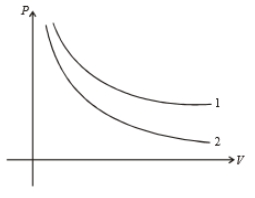

P-V graph of two gases during adiabatic processes are shown in figure. Plots 1 and 2 should correspond, respectively to :
1. He,
2. and He
3. He and Ar
4. and


For an ideal gas V-T curves at constant pressure and are shown in figure. From the figure


1.
2.
3.
4.
An ideal gas changes from state 'a' to state 'b' as shown in figure. What is the work done by the gas in the process?

1. zero
2. positive
3. negative
4. infinite
If is the work done in compressing an ideal gas from a given initial state through a certain volume isothermally and is the work done in compressing the same gas from the same initial state through the same volume adiabatically, then:
1.
2.
3.
4.
If 32 gm of \(O_2\) at \(27^{\circ}\mathrm{C}\) is mixed with 64 gm of \(O_2\) at \(327^{\circ}\mathrm{C}\) in an adiabatic vessel, then the final temperature of the mixture will be:
1. \(200^{\circ}\mathrm{C}\)
2. \(227^{\circ}\mathrm{C}\)
3. \(314.5^{\circ}\mathrm{C}\)
4. \(235.5^{\circ}\mathrm{C}\)
An ideal gas with adiabatic exponent y is heated at constant pressure and it absorbs Q heat. What fraction of this heat is used to perform external work?
1.
2.
3.
4.
For the indicator diagram given below, which of the following is not correct?

| 1. | Cycle II is a heat engine cycle. |
| 2. | Net work is done on the gas in cycle I. |
| 3. | Work done is positive for cycle I. |
| 4. | Work done is positive for cycle II. |
A given mass of gas expands from state \(A\) to state \(B\) by three paths \(1, 2~\text{and}~3\), as shown in the figure. If \(W_1, W_2~\text{and}~W_3\) respectively be the work done by the gas along the three paths, then:

| 1. | \(W_1 >W_2>W_3\) | 2. | \(W_1<W_2<W_3\) |
| 3. | \(W_1 =W_2=W_3\) | 4. | \(W_1 <W_2=W_3\) |
In a given process, dW = 0, dQ < 0, then for the gas:
1. Temperature increases
2. Volume decreases
3. Pressure decreases
4. Pressure increases

Match the following:
| Column I | Column II | ||
| \(P\). | Process-I | \(\mathrm{a}\). | Adiabatic |
| \(Q\). | Process-II | \(\mathrm{b}\). | Isobaric |
| \(R\). | Process-III | \(\mathrm{c}\). | Isochoric |
| \(S\). | Process-IV | \(\mathrm{d}\). | Isothermal |
| 1. | \(P \rightarrow \mathrm{a}, Q \rightarrow \mathrm{c}, R \rightarrow \mathrm{d}, S \rightarrow \mathrm{b}\) |
| 2. | \(P \rightarrow \mathrm{c}, Q \rightarrow \mathrm{a}, R \rightarrow \mathrm{d}, S \rightarrow b\) |
| 3. | \(P \rightarrow \mathrm{c}, Q \rightarrow \mathrm{d}, R \rightarrow \mathrm{b}, S \rightarrow \mathrm{a}\) |
| 4. | \(P \rightarrow \mathrm{c}, Q \rightarrow \mathrm{d}, R \rightarrow \mathrm{b}, S \rightarrow \mathrm{a}\) |






